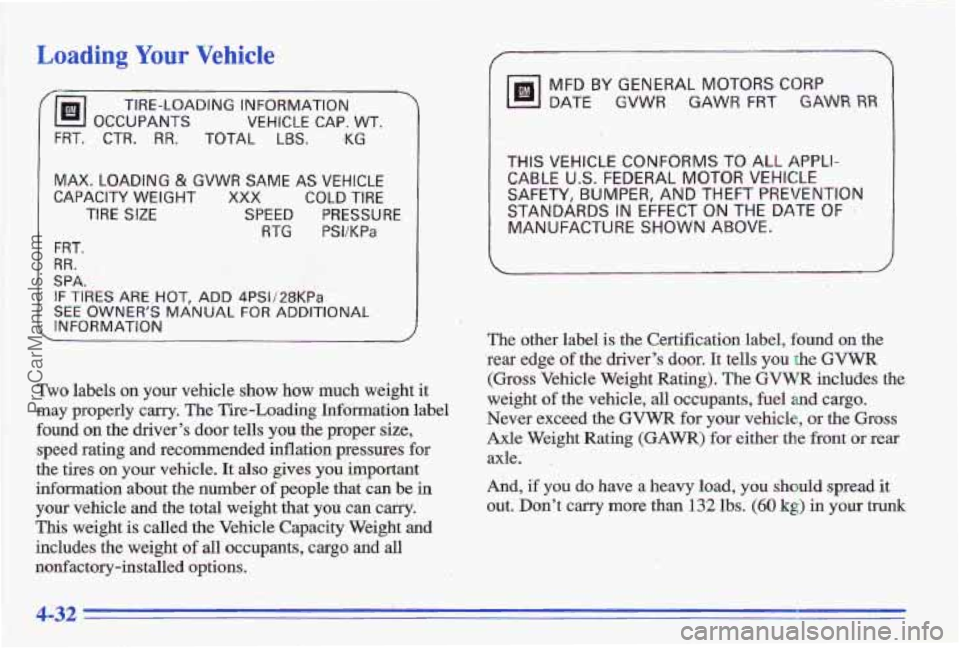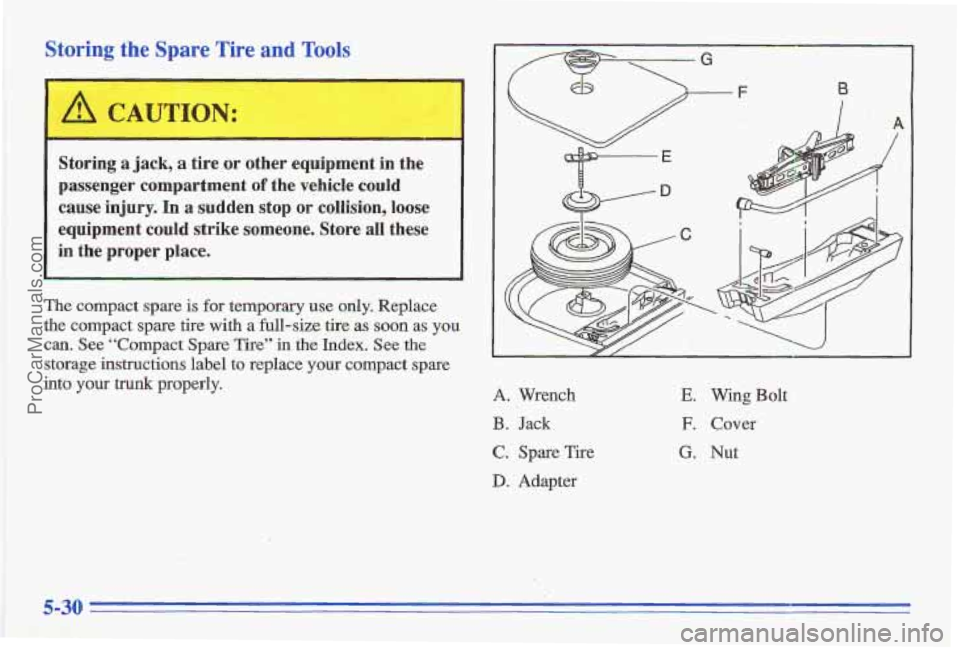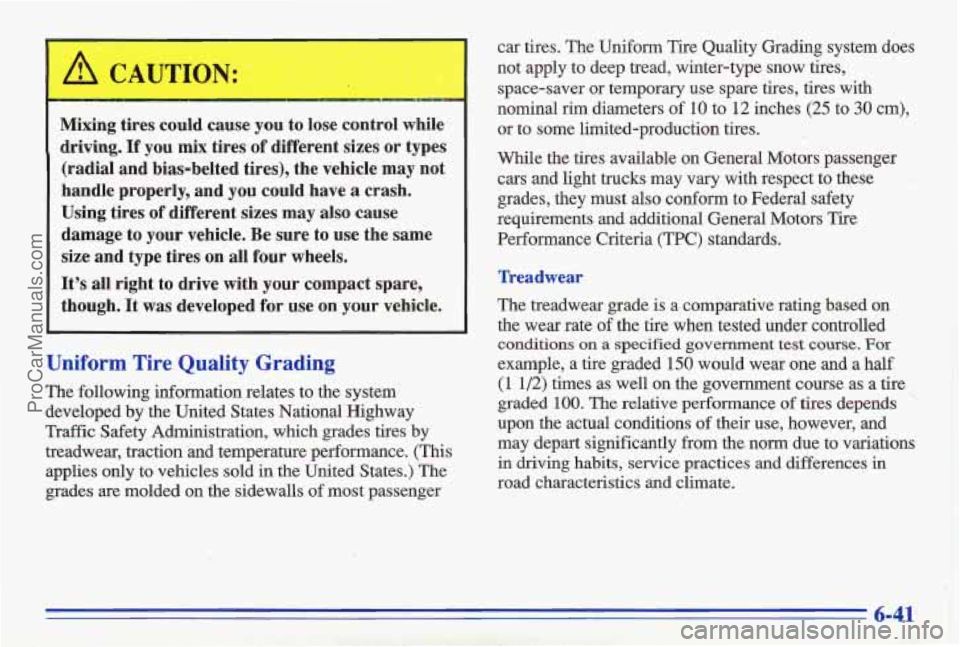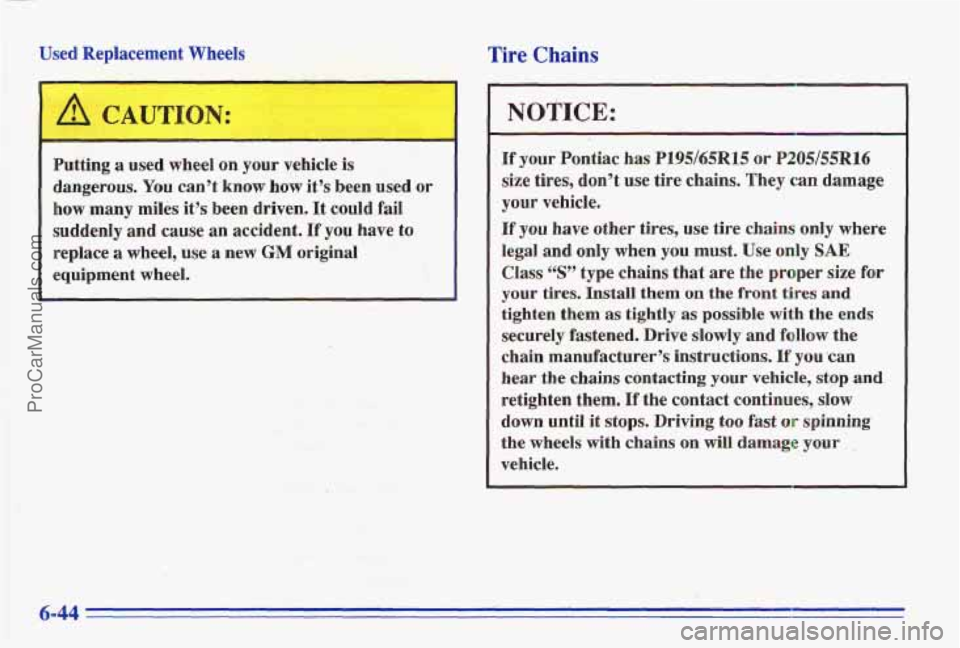1996 PONTIAC GRAND-AM tire size
[x] Cancel search: tire sizePage 180 of 356

Loading Your Vehicle
/@!!!I OCCUPANTS VEHICLE CAP. WT.
TIRE-LOADING INFORMATION
FRT. CTR. RR. TOTAL LBS. *KG
. ..
MAX. LOADING & GVWR SAME AS VEHICLE
CAPACITY WEIGHT XXX COLD TIRE
TIRE SIZE SPEED PRESSURE
FRT.
RTG PSI/KPa
RR.
SPA.
IF TIRES ARE,HOT, ADD 4PS1/28KPa
SEE OWNER'S MANUAL FOR ADDITIONAL
INFORMATION
Two labels on your vehicle show how much weight it
may properly carry. The Tire-Loading Information label
found on the driver's door tells
you the proper size,
speed rating and recommended inflation pressures for
the tires on
your vehicle. It also gives you important
information about
the number of people that can be in
your vehicle and the total weight that you can carry.
This weight is called the Vehicle Capacity Weight and
includes the weight of all occupants, cargo and all
nonfactory-installed
options.
THIS VEHICLE CONFORMS TO ALL APPLI-
SAFETY, BUMPER, AND THEFT PREVENTION
MANUFACTURE SHOWN ABOVE.
CABLE- U.S. FEDERAL MOTOR VEHICLE
STANDARDS IN EFFElCT ON THE DATE OF
The other label is the Certification label, found on the
rear edge of the driver's door. It tells you the GVMrR
(Gross Vehicle Weight Rating). The GVWa includes the
weight of the vehicle, all occupants, fuel and cargo.
Never exceed the
GVWa for your vehicle, or the Gruss
Axle Weight Rating (GAWR) for either the front or rear
axle.
.
And, if you do have a heavy load, you should spread it
out. Don't carry
more than 132 lbs. (60 kg) in your trunk
4-32
ProCarManuals.com
Page 220 of 356

Storing the Spare Tire and Tools
~~
A CAUTION:
I
i
Storing a jack, a tire or other equipment in the
p,assenger compartment
of the vehicle could
cause injury. In a sudden stop or collision, loose
equipment could strike someone., Store all these
in the proper place.
The compact spare is for temporary use only. Replace
the compact spare
tire with a full-size tire as soon as you
can. See “Compact Spare Tire” in the Index. See the
storage instructions label
to replace your compact spare
into your trunk properly. A. Wrench
B. Jack
C. Spare Tire
D. Adapter
E. Wing B.olt
F. Cov’er
G, Nut
5-30
ProCarManuals.com
Page 221 of 356

Compact Spare Tire
Although the compact spare tire was fully inflated’when
your vehicle was new, it can lose air after
a time. Check
the inflation pressure regularly.
It should be 60 psi
(42Q Wa).
After installing
the compact spare on your vehicle, you
should stop as soon as possible and make sure your
spare tire is correctly inflated. “The compact spare is
made to perfonnwell at posted speed limits for
distances up to.3,OOO miles
(5 000 km), so you can
finish your trip
and have your full-size tire repaired or
replaced where you want. Of course, it’s best to replace
your spare with a full-size tire as soon as you can. Your
spare
will last longer and be in good shape in case you
need it again.
NOTICE:
When the compact spare is installed, don’t take
your vehicle through,an automatic
car wash with
guide rails. The compact spare can get caught
on
the rails. That can damage the tire and wheel,
and maybe’ other parts
of your vehicle.
Don’t use your compact spare on other vehicles.
And don’t
mix your compact spare tire or wheel with
other wheels or tires. They won’t fit. Keep your spare
tire and its wheel together.
i
NOTICE:
Tire chains won’t fit your compact spare. Using
them can damage your vehicle and can damage
,the chains too. Don’t use tire chains on’-your
compact spare.
5-31
ProCarManuals.com
Page 259 of 356

Replacement blades come in different types and are removed in different ways. Here’s how to remove the
type with a release clip:
1. Pull the windshield wiper am away from the ‘
2. Lift the release clip with a screwdriver and pull the
3. Push the new wiper blade securely on the wiper arm.
For the proper type and size, see “Capacities and
Specifications”
in the Index.
windshield.
blade assembly
off the wiper arm.
Tires
We don’t make tires. Your new Pontiac comes with
highquality tires made by a leading tire manufacturer. If
you ever have questions about your tire warranty and
where to obtain service, see your Pontiac Warranty
booklet for details.
.-
Poorly maintained and improperly used tires are
dangerous.
Overloading your tires can cause
overheating as
a result of too much friction.
You could have an air-out and a serious
accident. See “Loading Your Vehicle” in the
Index.
Underinflated tires pose the same danger as
overloaded tires. The resulting accident
could cause serious injury.
Check all tires
frequently
to maintain the recommended
pressure. Tire pressure should be checked
when your tires are cold.
Overinflated tires are more likely
to be
cut, punctured or broken
by a sudden
impact
-- such as when you hit a pothole.
Keep tires at the recommended pressure.
Worn, old tires can cause accidents.
If your
tread is badly worn, or
if your tires have
been damaged, replace
them.
6-37
ProCarManuals.com
Page 262 of 356

When It’s Time for New Tires
I One wav to tell when it’s
time
fcinew tiies is to
check the treadwear
indicators, which will
,.
appear when your tires have
only 1/16 inch (1.6 rrim) or
less
of tread remaining.
I
You need a new tire if any of the following statements
are true:
, 1, .” ! , .
You cdsee the indicators at three or more places
.. .. . . (. , ;.--.-$ _. . .I :: , L. -. , &&&
-. .. . .I , .I 1 -
around the tire.
You can see cord or fabric showing through the tire’s
The tread or sidewall is cracked, cut or snagged deep
rubber.
enough to
show cord or fabric.
The tire has a bump, bulge or split.
The tire h’as a puncture, cut or other damage that
can’t be repaired
well because of the size or lo’cation
of the damage.
Buying New Tires
To find out what kind and size of tires you need, look at
the Tire-Loading Information label.
The
tires installed on your vehicle when it was new had
a Tire Performance Criteria Specification (TPC Spec)
number
on each tire’s sidewall. When you get new tires,
get ones with that same
TPC Spec number. That way
your vehicle will continue to have tires that are designed
to give proper endurance, handling, speed rating,
traction, ride
and other thing’s during normal service on
your vehicle. If your tires have an all-season tread
design, the
TPC number will be followed by an “MS”
(for mud and snow).
If you ever replace your tires with those not having a
TPC Spec nuhber, make sure they are the same size,
load
range, speed rating &d construction type (bias,
bias-belted
or radial) as your original tires.
..
6-40
ProCarManuals.com
Page 263 of 356

Mixing tires could cause you to lose control while
driving. If you mix tires of different sizes or types
(radial and bias-belted tires), the vehicle may not
handle properly, and you could.have
a crash.
Using tires of different sizes may also cause
damage to your vehicle. Be sure to use the same
size and type tires on all four wheels.
It's all right to drive with your compact spare,
though. It was developed for use on your vehicle.
Uniform Tire Quality Grading
The following information relates to the system
developed by the United States National Highway
Traffic Safety Administration, which grades tires by
treadwear, traction and temperature performance. (This applies only to'vehicles sold in the United States.)
The
grades are molded on the sidewalls of most passenger car tires. The Uniform Tire Quality Grading system does
not apply to deep tread, winter-type snow tires,
space-saver or temporqy use spare tires, tires with
nominal rim diameters of
10 to 12 inches (25 to 30 cm),
or to some limited-production tires.
While the tires available on General Motors passenger cars and light trucks may vary with respect to these
grades, they must also conform to Federal safety
requirements and additional General Motors Tire
Performance Criteria (TPC) standards.
Treadwear
The treadwear grade is a comparative rating based on
the wear rate
of the tire when tested under controlled
conditions on a specified government test course. For
example, a tire graded 150 would wear one and a half
(1 1/2) times as well on the government course as a tire
graded
100. The relative performance of'tires depends "
upon the actual conditions of their use, however, and
may depart significantly from the norm due to variations
in driving habits, service practices and differences in
road characteristics and climate.
ProCarManuals.com
Page 266 of 356

Used Replacement Wheels Tire Chains
A CAUTION:
Putting a used wheel on your vehicle is
dangerous.
You can’t know how it’s been used or
how many miles it’s been driven. It could fail
suddenly and cause an accident.
If you have to
replace
a wheel, use a new GM original
equipment wheel.
NOTICE:
If your Pontiac has P195/65R15 or P205/55R16
size tires, don’t use tire chains. They can damage
your vehicle.
If you have other tires, use tire chains only where
legal and only when you
must. Use only SAE
Class “S” type chains that are the proper size for
your tires. Install them on the front tires and
tighten them as tightly as possible with the ends
securely fastened. Drive slowly and follow the
chain manufacturer’s instructions.
If you ’can
hear the chains contacting your vehicle, stop and
retighten them.
If the contact continues, slow
down until it stops. Driving
too fast or spinning
the wheels
with chains on will damage your
vehicle.
6-44
ProCarManuals.com
Page 282 of 356

Capacities and Specifications
Engine Crankcase
2.4LEngine ...........................................
3.1LEngine ...........................................
Pan Removal and Replacement ............................
After Complete Overhaul ................................
Automatic Transaxle
When draining or replacing torque converter, more fluid may be needed.
Manual mansaxle
Complete Drain and,Refill ...............................
Cooling System
2.4LEngine ............................................
3.1LEngine ............................................
Refrigerant, Air Conditioning
See refrigerant charge label und'er hood.
FuelTank .............................................
Tire Pressures, Sizes ....................................
4.0 quarts (3.8 L)
4.5 quarts (4.3 L)
6.0 quarts (5.7 L)
8.0 quarts (7.6 L)
2.0 quarts (1.9 L)
11.3 quarts (10.7 L)
13.6 quarts (12.9 L)
15.2 gallons (57.5 L)
See Tire-Loading Information
label
on driver's door.
100 lb-ft (140 N-m) WheeINutTorque ......................................
Windshield Wiper Blade (Pin Type)
Length ............................................... 19 inches (48 cm)
PartNumber
.......................................... 22155381
Note:
All capacities are approximate. When adding, be sure to fill to the appropriate level or as recommended in this manual.
6-60
ProCarManuals.com